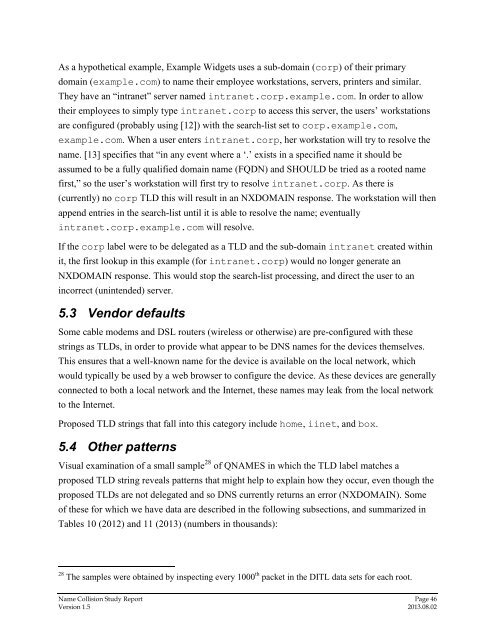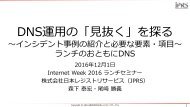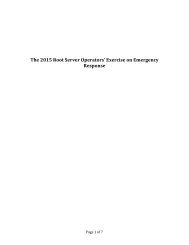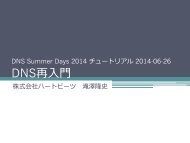You also want an ePaper? Increase the reach of your titles
YUMPU automatically turns print PDFs into web optimized ePapers that Google loves.
As a hypothetical example, Example Widgets uses a sub-domain (corp) of their primary<br />
domain (example.com) to <strong>name</strong> their employee workstations, servers, printers and similar.<br />
They have an “intranet” server <strong>name</strong>d intranet.corp.example.com. In order to allow<br />
their employees to simply type intranet.corp to access this server, the users’ workstations<br />
are configured (probably using [12]) with the search-list set to corp.example.com,<br />
example.com. Wh<strong>en</strong> a user <strong>en</strong>ters intranet.corp, her workstation will try to resolve the<br />
<strong>name</strong>. [13] specifies that “in any ev<strong>en</strong>t where a ‘.’ exists in a specified <strong>name</strong> it should be<br />
assumed to be a fully qualified domain <strong>name</strong> (FQDN) and SHOULD be tried as a rooted <strong>name</strong><br />
first,” so the user’s workstation will first try to resolve intranet.corp. As there is<br />
(curr<strong>en</strong>tly) no corp TLD this will result in an NXDOMAIN response. The workstation will th<strong>en</strong><br />
app<strong>en</strong>d <strong>en</strong>tries in the search-list until it is able to resolve the <strong>name</strong>; ev<strong>en</strong>tually<br />
intranet.corp.example.com will resolve.<br />
If the corp label were to be delegated as a TLD and the sub-domain intranet created within<br />
it, the first lookup in this example (for intranet.corp) would no longer g<strong>en</strong>erate an<br />
NXDOMAIN response. This would stop the search-list processing, and direct the user to an<br />
incorrect (unint<strong>en</strong>ded) server.<br />
5.3 V<strong>en</strong>dor defaults<br />
Some cable modems and DSL routers (wireless or otherwise) are pre-configured with these<br />
strings as TLDs, in order to provide what appear to be DNS <strong>name</strong>s for the devices themselves.<br />
This <strong>en</strong>sures that a well-known <strong>name</strong> for the device is available on the local network, which<br />
would typically be used by a web browser to configure the device. As these devices are g<strong>en</strong>erally<br />
connected to both a local network and the Internet, these <strong>name</strong>s may leak from the local network<br />
to the Internet.<br />
Proposed TLD strings that fall into this category include home, iinet, and box.<br />
5.4 Other patterns<br />
Visual examination of a small sample 28 of QNAMES in which the TLD label matches a<br />
proposed TLD string reveals patterns that might help to explain how they occur, ev<strong>en</strong> though the<br />
proposed TLDs are not delegated and so DNS curr<strong>en</strong>tly returns an error (NXDOMAIN). Some<br />
of these for which we have data are described in the following subsections, and summarized in<br />
Tables 10 (2012) and 11 (2013) (numbers in thousands):<br />
28 The samples were obtained by inspecting every 1000 th packet in the DITL data sets for each root.<br />
Name Collision Study Report Page 46<br />
Version 1.5 2013.08.02







